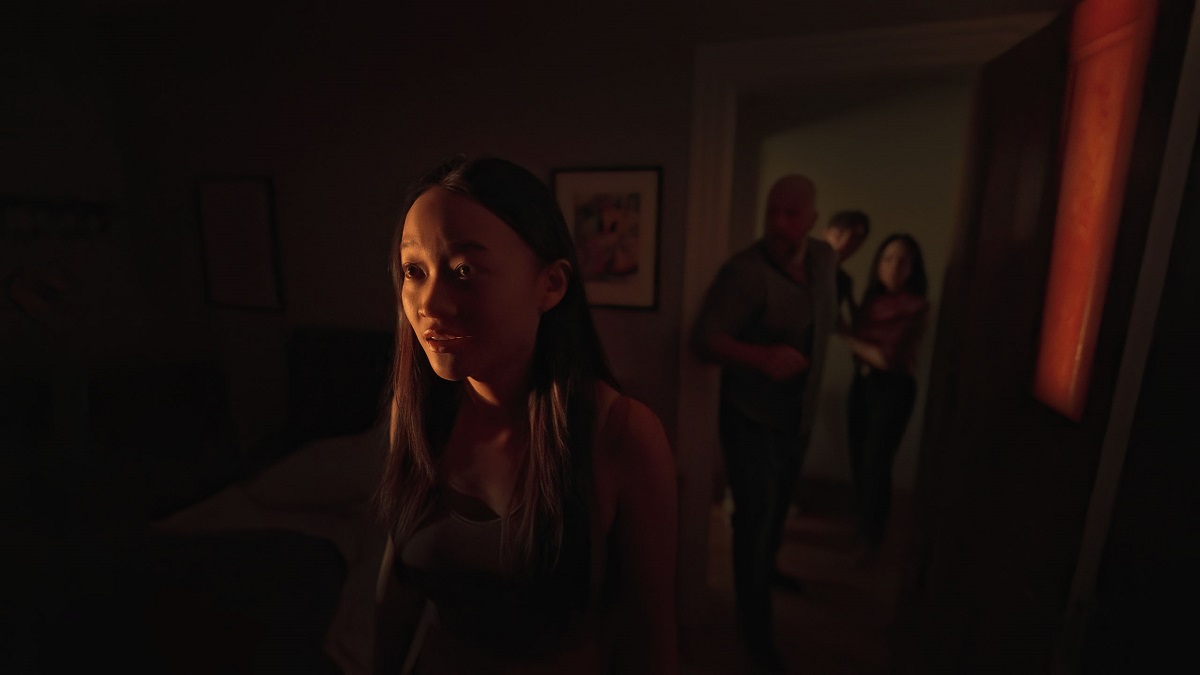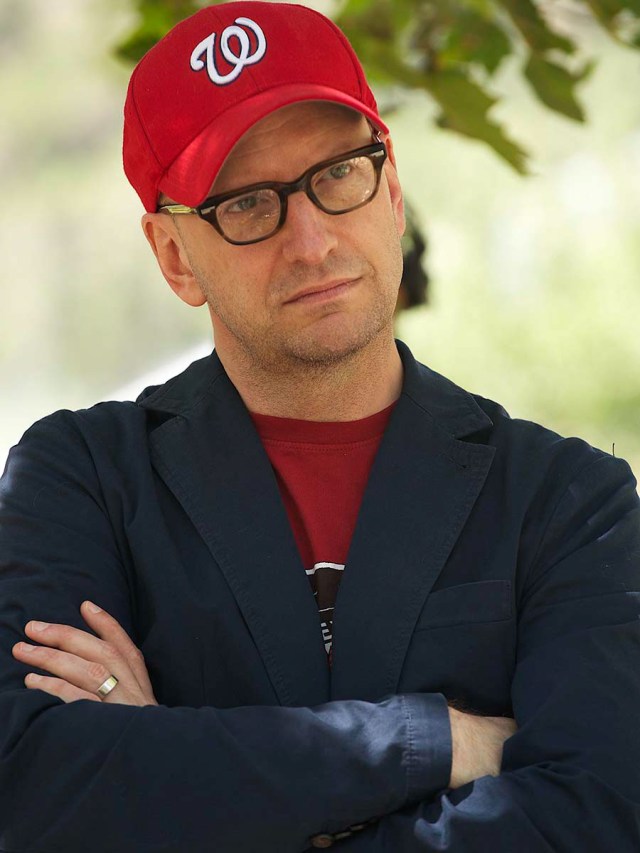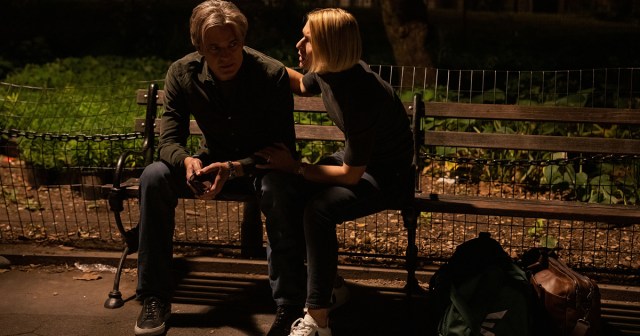
TL;DR
- Steven Soderbergh’s spooky ghost story “Presence” is shot entirely from the ghost’s perspective even though he previously thought point-of-view movies wouldn’t work.
- Shooting under his usual DP pseudonym of Peter Andrews, Soderbergh guides his subjective camera into every corner of the house, opening up a number of questions that film theorists and film buffs will gorge on.
Steven Soderburgh’s latest film is a riff on the haunted house genre with the twist being that the spooky story is told from the ghost’s point of view.
In Presence a family moves into a new home only to recognize an unsettling feeling that something or someone else is also there. The script is by regular Soderbergh collaborator David Koepp, from an idea by the auteur and stars Lucy Liu, Chris Sullivan, Callina Liang, and Julia Fox.
The story may be familiar, but it is the filmmaker’s camerawork that makes the movie stand out from the horror pack.
“The camera drifts through spaces, hovers around actors, races up and down stairs, and looks out windows — usually in single takes that constitute the entirety of a scene,” describes Bilge Ebiri for Vulture. “Nobody can see this presence, but they do occasionally sense it.”
READ MORE: Presence Is the Best Thing Steven Soderbergh’s Done in Ages (Vulture)
Lots of films will occasionally cut away to the ghost’s or killer’s or monster’s point of view for some visual flair and added tension. Ebiri notes that Dario Argento perfected the idea in his giallo classics. Sam Raimi turned it into the ultimate lo-fi aesthetic in his Evil Dead movies. Stanley Kubrick riffed on it in The Shining.
“The technique is nothing new,” says Ebiri. “But Soderbergh doesn’t use it as an occasional directorial indulgence, instead maintaining the ghost’s-eye perspective throughout the whole movie. The camera’s presence, the question of where it goes and why, and which characters it focuses on, thus all go from stylistic questions to narrative and thematic ones.”

Previously Soderbergh has been disparaging about creating narrative films told entirely from a first person perspective but he now appears to have changed his mind. During the post-screening Q&A at Sundance, as reported by TheWrap, he admitted:
“I had real questions about the choice that was at the center of this, because I’ve been very vocal about the fact that first person POV VR is never going to work as a narrative. They want to see a reverse angle of the protagonist with an emotion on their face experiencing the thing. I’ve been beating this drum for a long time — it’s never going to work.”
“The only way to do it was you never turn around,” Soderbergh continued. “It was really fun because there was no other plan. That’s it. You live or die by that.”
As TheWrap’s Drew Taylor observed, the Oscar-winning Ocean’s 11 and Traffic filmmaker is prone to experimentation, like shooting features on iPhones or self-releasing entire shows through his website.
“Presence is another big stylistic swing that connects. Ironically, it’s not hard to imagine the film becoming a hit on VR headsets.”
READ MORE: ‘Presence’ ‘Director Steven Soderbergh Thought First-Person VR Would Never Work, Then He Did Just That (TheWrap)
As is now his custom, Soderbergh is also behind the camera, acting as his own DP under the pseudonym Peter Andrews, which adds another meta layer of analysis for film theory buffs.
“The unseen figure of the ghost becomes an expression of the filmmaker’s power over the frame, evoking the sadistic-voyeuristic nature of cinema in general and genre cinema in particular,” says Ebiri.
He used the newest iteration of the Sony DSLR, which was small and light enough for him to carry for those extended takes, and wore martial arts slippers while sliding around the house to make as little noise as possible.
This presented two challenges, he told Amy Taubin at Filmmaker Magazine. “It probably weighed 10 or 12 pounds, which is fine unless you have to hold it out in front of you for eight minutes. Then it gets hard. A couple of takes are that long, especially the penultimate shot, where there’s a lot going on. My arms are turning to cement.”
The other challenge was the stairs. “I was in that house for a month and there’s no version of me going up and down those stairs without having to look at my feet. What that meant was I had to do a series of rehearsals where I got a sense of where to aim the camera and where I could just feel the level of tilt and pan that would result in the correct composition without looking through the lens. But sometimes I’d get it wrong, and I would ruin a take halfway through.”
The director also edits (billing himself as Mary Ann Bernard) and told the post-screening Sundance audience, as reported by The Hollywood Reporter, that for him this is the most creative part of the process.
“There’s no analogous sort of tasks in any other art form. You’re bringing it all together, all the elements,” he said. “Sound, picture — it is the best. It’s the reward for being on set. The power of it still amazes me. How you can change the intention of something just by reordering shots or holding them at a certain length, pulling out lines, giving a line to somebody else.”
Soderbergh has apparently experienced some sort of unsettling behavior in his own house where a previous owner had been killed.
“The circumstances surrounding it were very murky, but everybody on the block was convinced that this was not a suicide, as the police described it, but that her daughter had killed her,” he revealed to Filmmaker. “As the son of a parapsychologist, I found that fascinating.”
Also during the Q&A, he talked about the film’s climax and likely to be most talked about scene. This was scripted by Koepp and one that not even Soderbergh expected. Taubin describes the sequence as “a horrific close-up of an act of violence that mesmerizes the camera — just as horror films mesmerize their audience.”
READ MORE: Sundance: Steven Soderbergh Reveals the Auteur Rule He Broke to Make Ghost Story ‘Presence’ (The Hollywood Reporter)
Anyone who has seen Michael Powell’s Peeping Tom may be able to guess what Soderbergh was trying to achieve.
“When I read that scene for the first time, I thought, “Wow, that’s, that’s rough,” and was immediately aware of the sort of philosophical point that you just made. What I didn’t know was how amplified and extreme it would be when we were actually there doing it. My decision ultimately was that it had to be excruciatingly intimate. Which is, you know, 14 inches from a very personal form of murder.”
He also admitted in his interview with Taubin that he is not an aficionado of horror films; “You see a lot of horror films that feel very much like single-use plastic, where you don’t really think about them again,” but what attracted him to the genre was “this whole idea of directorial presence. It’s what the whole thing is built on.”
READ MORE: “14 Inches From a Very Personal Form of Murder”: Steven Soderbergh on Camera as Character and His Sundance Horror Film, Presence (Filmmaker Magazine)
Nonetheless, critics don’t consider Presence a frightening movie noting the absence of conventional jump-scares.
THR critic David Rooney judged it “an enormously satisfying watch for haunted house movie fans, favoring sustained anxiety over big scares and practical effects over digital trickery.”
READ MORE: ‘Presence’ Review: Steven Soderbergh Spins a Nail-Biting Ghost Story, Working Magic in a Single Setting (The Hollywood Reporter)
Variety’s Owen Gleiberman has problems with the conceit. He writes “we’re just watching a shoestring movie shot with a rather nosy and flamboyant visual style. All very stylish and percussive. But if he had made a version of this movie without the ghost-as-camera-eye conceit, it would have been more or less the same movie.”
He adds, that Presence amounts to “another half-diverting, half-satisfying Soderbergh bauble, only this time he’s the ghost in the machine.”


